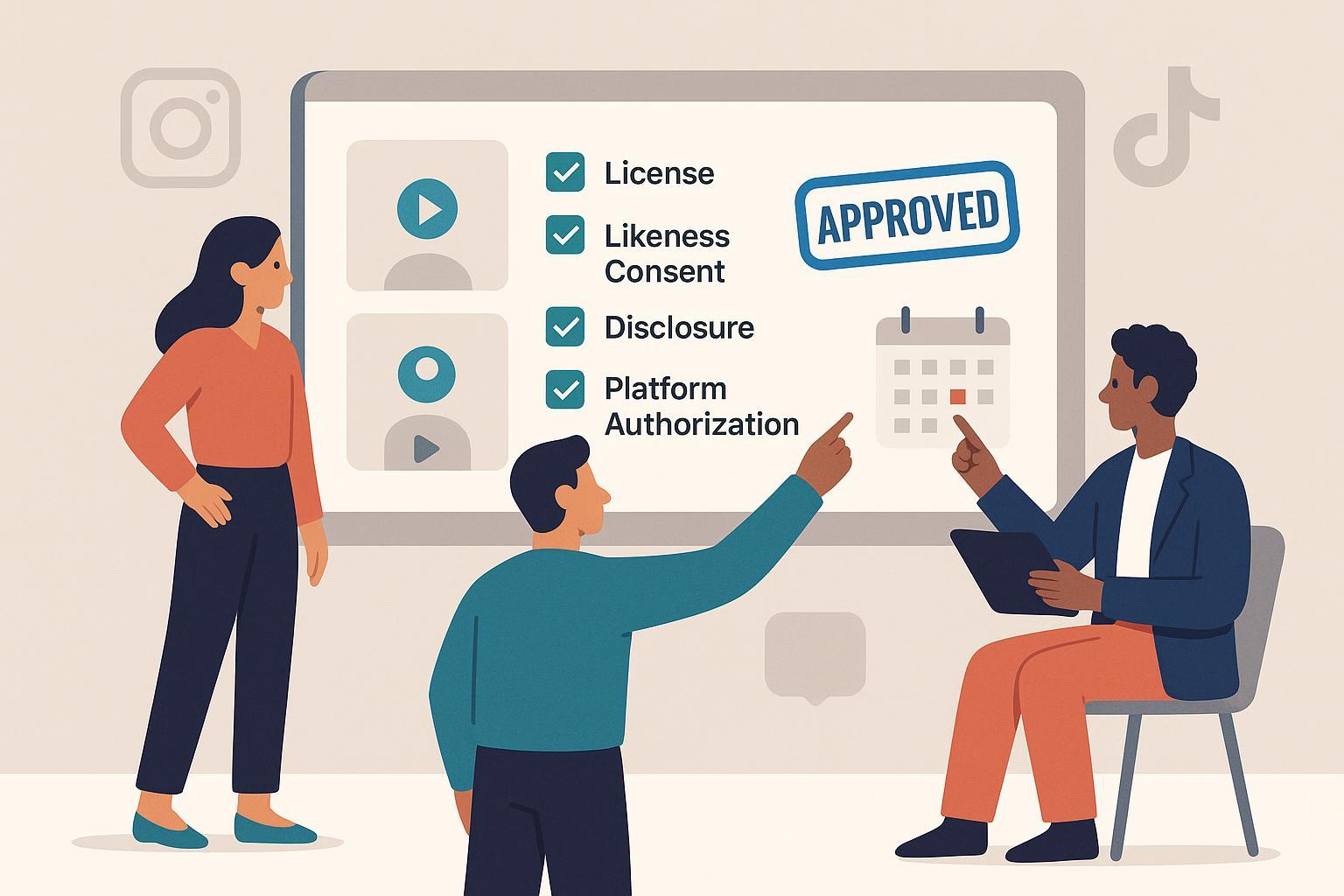UGC Rights Management 2.0: A Practical Definition, Workflow, and Toolbox

User-Generated Content (UGC) Rights Management 2.0 is the modern, end-to-end approach brands use to lawfully obtain, track, and govern permissions to reuse creators’ posts across channels. It blends the legal foundations (copyright and publicity/privacy), regulator expectations for truthful, clearly disclosed endorsements, platform-native authorization tools (Instagram partnership ads, TikTok Spark Ads), and operational controls like consent capture, audit trails, renewals, and revocations.
In other words: it’s how you move from “we found a great customer video” to “we’re allowed to use it on our site and in ads—documented, disclosed, and compliant.”
Key takeaways
- By default, the creator owns copyright in their content; brands typically need a license to reuse it, and separate likeness consent if identifiable people appear.
- The FTC’s 2023 updates raised the bar for clear-and-conspicuous disclosures and reinforced advertiser liability when amplifying UGC without appropriate disclosures or substantiation.
- Platform tools (Instagram Paid Partnership/Partnership Ads, TikTok Spark Ads) facilitate authorization and labeling, but they don’t replace licenses or legal disclosures.
- GDPR and similar privacy laws can require demonstrable, withdrawable consent when using identifiable images of EU/EEA individuals.
- A workable program documents everything: request → grant → record → platform authorization → disclose and deploy → monitor/renew/revoke.
How UGC rights work (the legal bedrock)
Copyright ownership and licenses
By default in the U.S., the human creator owns copyright and the exclusive rights to reproduce, distribute, publicly display, and create derivative works. A brand that wants to reuse UGC (and especially to edit it) typically needs a license that covers those rights. See the statutory overview of exclusive rights in the U.S. Copyright Act as compiled by the U.S. Copyright Office in Title 17, Chapter 1 (exclusive rights and derivative works) in the Office’s publication: Title 17, Chapter 1 (statutory text, U.S. Copyright Office). For what counts as protectable authorship, consult the Office’s Compendium Chapter 300 on copyrightable authorship.
Publicity/likeness rights are separate from copyright
Even with a copyright license, you may need a person’s consent to use their name, image, or likeness for commercial purposes. Publicity rights are distinct (often state-level) protections for identity, separate from copyright. For orientation, compare the scope of copyright in the Library of Congress’s Understanding Copyright overview with a general explanation of publicity and media rights in Cornell Law’s Media/Publicity rights overview.
AI-assisted UGC and human authorship
Copyright requires a human author. The U.S. Copyright Office explains that AI-generated material is protected only to the extent of the human creative contributions; applicants must disclose AI’s role when seeking registration. See the Office’s AI Policy Guidance (2023). This matters when licensing UGC that contains AI-generated elements—be clear what you’re actually getting rights to.
What changed recently: FTC, Instagram, and TikTok
FTC Endorsement Guides (2023 update)
In June 2023, the FTC updated its Endorsement Guides, emphasizing that disclosures must be clear and conspicuous—difficult to miss and easily understandable—and that advertisers can be liable when they boost, curate, or edit endorsements in misleading ways. Review the FTC’s plain‑English FAQ: Endorsement Guides: What People Are Asking (updated) and the FTC’s press release announcing the 2023 updates. For audiovisual content, the FTC has also highlighted that relying solely on platform labels may be insufficient if disclosures aren’t visible/audible—see an example FTC warning letter emphasizing clear video disclosures (Nov 2023). The FTC’s resource hub for advertisers is here: Endorsements, Influencers, Reviews (business guidance).
Instagram: Branded content, Paid Partnership label, and Partnership Ads
Instagram requires branded content to be labeled with the Paid Partnership tag; creators and brands must use the branded content tools and satisfy eligibility conditions if posts will be turned into ads as Partnership Ads. Start with Instagram’s branded content policies and Paid Partnership guidance and the workflow for About partnership ads (formerly branded content ads). These tools facilitate authorization and labeling inside Instagram’s ecosystem—they don’t grant you an off‑platform IP license by themselves.
TikTok: Spark Ads authorization and branded content disclosures
TikTok’s Spark Ads let advertisers promote a creator’s existing post with explicit authorization (via Business Center access or video codes). Review the Spark Ads creation guide and the Business Center authorization workflow. TikTok also requires turning on branded content disclosures where appropriate; see Promoting a brand, product, or service (disclosure tools). As with Instagram, these platform flows complement—rather than replace—licenses and consent.
GDPR consent standards (if identifiable individuals appear)
If you process personal data (like identifiable images) of people in the EU/EEA for marketing, consent may need to be freely given, specific, informed, unambiguous—and withdrawal must be as easy as giving it. Controllers must be able to demonstrate valid consent. See the EDPB’s Guidelines on Consent under the GDPR (WP259 rev.01).
The UGC Rights Management 2.0 workflow (request → grant → document → use → renew)
- Discover and vet content
- Verify the original creator and any third‑party rights (music, logos, co‑creators). If the content is AI‑assisted, assess the extent of human authorship per the U.S. Copyright Office’s AI Policy Guidance.
- Request permissions and obtain consent
- Ask the creator for written permission that clearly specifies scope (channels/placements/formats), term, territory, exclusivity, editing/derivative rights, attribution, and revocation/withdrawal terms. If identifiable people appear, obtain likeness consent. If there’s a material connection (gifted product, incentive), prepare the appropriate disclosures under the FTC’s Endorsement Guides FAQ.
- Recordkeeping and audit trail
- Store the license/consent terms, creator handles/IDs, links and screenshots of the original post with timestamps, any platform authorization IDs (e.g., TikTok video codes), and the disclosure instructions you provided. The FTC’s business guidance hub underscores having substantiation and disclosure records: Endorsements, Influencers, Reviews.
- Platform-native authorization
- Instagram: Ensure the creator tags your brand and enables Partnership Ads if you plan to run their post as an ad; keep the Paid Partnership label visible per Instagram’s branded content policies and About partnership ads.
- TikTok: Obtain Spark Ads authorization via Business Center access or per‑video codes; understand and log how revocation affects ad delivery per the Spark Ads guide.
- Deploy with disclosures and IP checks
- In all placements (owned and paid), make disclosures clear and conspicuous—especially in video, where on‑screen and audible cues may both be needed—per the FTC’s Endorsement Guides FAQ. Double‑check music and other third‑party IP rights (see Instagram’s branded content/IP guidance).
- Monitor, renew, revoke, or sunset
- Track end dates and terms for renewal. Be prepared to cease use quickly if consent is withdrawn or a platform authorization is revoked; assess impacts on ad delivery using TikTok’s ad statuses and definitions. In the EU/EEA, ensure withdrawal is as easy as giving consent per the EDPB consent guidelines.
Mini‑checklist: What to capture in your request and logs
- Parties and contact handles; source URLs and screenshots
- Scope: channels, placements, formats; derivative/editing rights
- Term and territory; exclusivity; revocation/withdrawal terms
- Attribution/credit and disclosure obligations
- Likeness consent for any identifiable individuals; age/children protections
- Platform authorizations (IG partnership ads; TikTok Spark Ads codes)
- Third‑party IP (music, trademarks) clearance
- Storage location, retention policy, and withdrawal process
Pitfalls and myths to avoid
- “Public = free to use.” A public post does not grant commercial rights. You still need a license from the copyright owner; see the U.S. Copyright Office’s summary of exclusive rights in Title 17, Chapter 1.
- “Hashtag = consent.” Operational hashtags (e.g., #yesBrand) can help, but unless your terms are clear, conspicuous, and demonstrably accepted, they’re risky. The FTC expects disclosures to be difficult to miss and easily understandable—see the Endorsement Guides FAQ.
- “Platform tag = full compliance.” Relying only on platform labels may be insufficient, especially in video, where disclosures must be truly noticeable; see an example FTC warning letter emphasizing video disclosures.
- “Copyright license covers likeness.” It doesn’t. Publicity/likeness consent is separate from copyright licensing—compare the LOC’s overview of copyright with Cornell’s publicity/media rights explainer.
- “AI UGC is always copyrightable.” Not necessarily; protection only covers the human‑authored contributions. See the U.S. Copyright Office’s AI Policy Guidance.
Practical scenarios (step-by-step)
Scenario A: Reusing a customer’s TikTok video on your website and in paid ads
- Permissions: DM or email a clear request for website and paid advertising use (TikTok, Meta, YouTube) for 12 months, worldwide, non‑exclusive, with rights to edit/caption; obtain likeness consent for any identifiable people.
- Authorization: Get Spark Ads authorization through Business Center access or per‑video codes; record the code and terms; see the Spark Ads creation guide.
- Disclosures: If any material connection exists (gifted product, incentive), ensure clear, conspicuous disclosures per the FTC Endorsement FAQ.
- Records: Store the permission, consent forms, screenshots, and ad IDs; monitor revocation impacts using TikTok’s ad status definitions.
Scenario B: Turning an Instagram creator’s Reel into an ad
- Permissions: Have the creator tag your brand and enable Partnership Ads; confirm eligibility; see About partnership ads.
- Labeling: Ensure the Paid Partnership label is visible per Instagram’s branded content policies and that disclosures aren’t solely reliant on platform labels per the FTC FAQ.
- IP checks: Verify music and other third‑party rights are cleared for ad usage.
Scenario C: Consent withdrawal mid‑campaign with EU/EEA audiences
- Action: Stop processing and remove content where feasible; make withdrawal as easy as consent; document the change and notify internal teams. Reference the EDPB’s Consent Guidelines (paras. 46–48).
What UGC Rights Management 2.0 is not
- Not just a hashtag policy. Hashtags can help organize responses but don’t create airtight licenses or satisfy disclosure duties.
- Not only a platform toggle. IG/TikTok tools facilitate but don’t replace legal permissions and disclosures.
- Not purely legal paperwork. You also need operational guardrails—systems, logs, and renewal/revocation workflows.
Do/Don’t quick list
- Do: Specify scope, term, territory, formats, editing rights, attribution, exclusivity, revocation terms.
- Do: Keep an audit trail (contracts, screenshots, IDs, authorizations, disclosures).
- Do: Use platform-native authorization for ads (Partnership Ads; Spark Ads) and ensure labels are visible.
- Don’t: Assume public posts or tags grant rights.
- Don’t: Rely on platform labels as your only disclosure method—make disclosures clear and conspicuous.
- Don’t: Confuse copyright licenses with likeness consent.
Toolbox: Software and workflows for UGC rights
Building your stack typically involves (a) a rights/UGC platform to request and track permissions and (b) your content operations/publishing system. Neutral examples below—verify current features and data protection addenda directly with each vendor.
- FADEL: Enterprise asset rights and royalty management with governance features suited to complex organizations.
- TINT (Olapic heritage) and Stackla (Nosto): UGC discovery, curation, and rights request flows with onsite galleries and commerce tie‑ins.
- Emplifi (Pixlee) and CrowdRiff (travel/DMOs): Discovery, permissions workflows, and visual galleries; CrowdRiff is popular with travel and destination brands.
- EmbedSocial and Later: Social-first aggregation and lightweight permissions capture for campaigns and microsites.
- QuickCreator (Disclosure: QuickCreator is our product.): A content operations and publishing platform that can host approved UGC sections on websites/blogs and help teams keep internal notes about consent status within their publishing workflow. It complements—rather than replaces—a dedicated rights management system.
When to choose what (high level)
- Enterprise compliance and complex rights matrices: FADEL.
- Commerce personalization and onsite UGC carousels: Nosto (Stackla), Emplifi (Pixlee).
- Social-first campaigns with lightweight rights capture: TINT, Later, EmbedSocial.
- Travel/locations-rich visual programs: CrowdRiff.
- Content operations and multi-language publishing alongside a rights tool: QuickCreator.
Related concepts (quick clarifiers)
- License vs. consent: A license grants permission to use the creative work (copyright). Consent addresses a person’s identity/likeness and, in some jurisdictions, data protection. You often need both.
- Platform authorization vs. IP license: Granting Spark Ads or IG Partnership Ads permission enables ad delivery—but it doesn’t alone grant comprehensive off‑platform rights.
- Disclosure vs. endorsement: Disclosure makes material connections transparent; endorsements must also be truthful and substantiated per the FTC’s 2023 updates.
Bottom line (and a quick legal note)
UGC Rights Management 2.0 formalizes what savvy teams already do: respect creators, obtain licenses and likeness consent where needed, use platform tools correctly, document everything, and maintain the ability to renew or withdraw quickly. That combination reduces infringement risk, meets regulator expectations, and preserves audience trust.
This article is general information, not legal advice. Laws vary by jurisdiction (e.g., state publicity rights; minors; post‑mortem rights). For high‑stakes or unusual cases, consult qualified counsel and verify current platform policies before launch.

